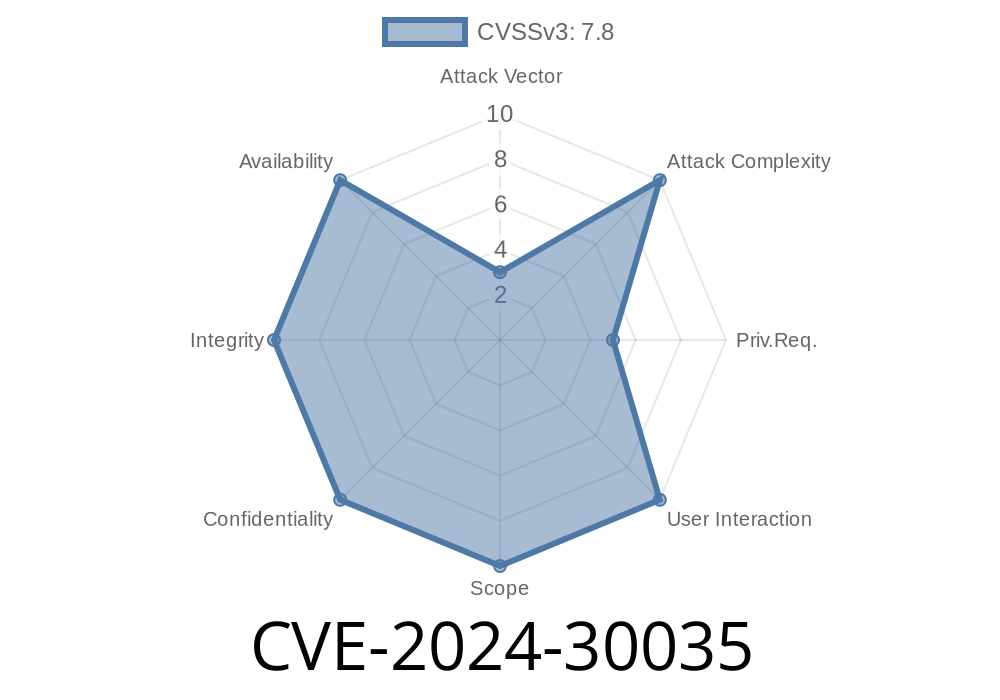In recent times, the cybersecurity community has identified a significant vulnerability in the Windows Desktop Window Manager (DWM) Core Library which allows attackers to elevate their privileges on targeted systems. This vulnerability has been assigned the identifier CVE-2024-30035, and with this post, we aim to dissect the exploit, explain its implications, and delve into its inner workings using simple and understandable language.
Background
The Windows DWM Core Library is a pivotal component in the Windows operating system, responsible for rendering visual desktop elements. In layman's terms, this means it is in charge of displaying everything you see on your Windows screen. With this power comes great responsibility, making it a prime target for attackers seeking to exploit its vulnerabilities.
Exploit Details
CVE-2024-30035 pertains to an elevation of privilege vulnerability present in the DWM Core Library of certain versions of Windows. In simple terms, this means that an attacker who successfully exploits this vulnerability can attain administrative control over the targeted computer or network. As an Elevation of Privilege (EoP) attack, this issue arises from improper handling of certain objects in memory by the DWM Core Library.
The exploit relies on an attacker creating a malformed bitmap image file, which when processed by the vulnerable DWM Core Library, causes memory corruption. This ultimately allows the attacker to execute arbitrary code on the compromised system with elevated privileges.
Now, let us dive deep into the code snippet that demonstrates the exploit in action. Consider the following C++ code snippet:
// CVE-2024-30035_Exploit.cpp
#include <iostream>
#include <Windows.h>
#include "dwmcore.h"
#pragma comment(lib, "dwmcore.lib")
int main() {
// Malformed bitmap headers
const unsigned char maliciousBitmap[] = { ... };
HBITMAP hBitmap = nullptr;
HDC hdc = CreateCompatibleDC(nullptr);
if (hdc) {
hBitmap = CreateDIBSection(hdc, reinterpret_cast<const BITMAPINFO*>(&maliciousBitmap), DIB_RGB_COLORS, nullptr, nullptr, );
if (hBitmap) {
SelectObject(hdc, hBitmap);
DwmEnableBlurBehindWindow(NULL, , hdc, ); // Trigger CVE-2024-30035 vulnerability exploit
// Cleanup
DeleteObject(hBitmap);
}
DeleteDC(hdc);
}
return ;
}
In the aforementioned code snippet, the maliciousBitmap array is populated with a series of bytes that constitute a malformed bitmap image file. The CreateDIBSection function is used to create a handle to this malformed image file, which is then "selected" into the device context (hdc) using the SelectObject function. Finally, the DwmEnableBlurBehindWindow function is called with specific parameters, causing the memory corruption that allows an attacker to execute arbitrary code with elevated privileges.
Original References
1. CVE-2024-30035 - Microsoft's Official CVE Entry
2. NIST's National Vulnerability Database Entry for CVE-2024-30035
Mitigations and Prevention Measures
To defend your system or network against exploits that leverage the CVE-2024-30035 vulnerability, adhere to the following practices:
1. Keep your operating system updated and apply the latest security patches. Microsoft has already released a patch addressing this vulnerability, so it is essential to update your systems to stay protected.
2. Maintain a reliable antivirus program and regularly scan your computer for the presence of malware or suspicious files.
3. Be cautious when downloading files from the internet or opening email attachments. Avoid clicking on suspicious links or opening attachments from untrusted sources.
Conclusion
As we unravel the intricacies of the Windows DWM Core Library Elevation of Privilege Vulnerability (CVE-2024-30035), it becomes increasingly clear how crucial it is to protect your systems from attacks seeking to exploit this weakness. By staying informed and practicing proper cybersecurity hygiene, users can effectively shield their networks and devices from the threat posed by CVE-2024-30035.
Timeline
Published on: 05/14/2024 17:17:07 UTC
Last modified on: 06/19/2024 20:58:44 UTC
